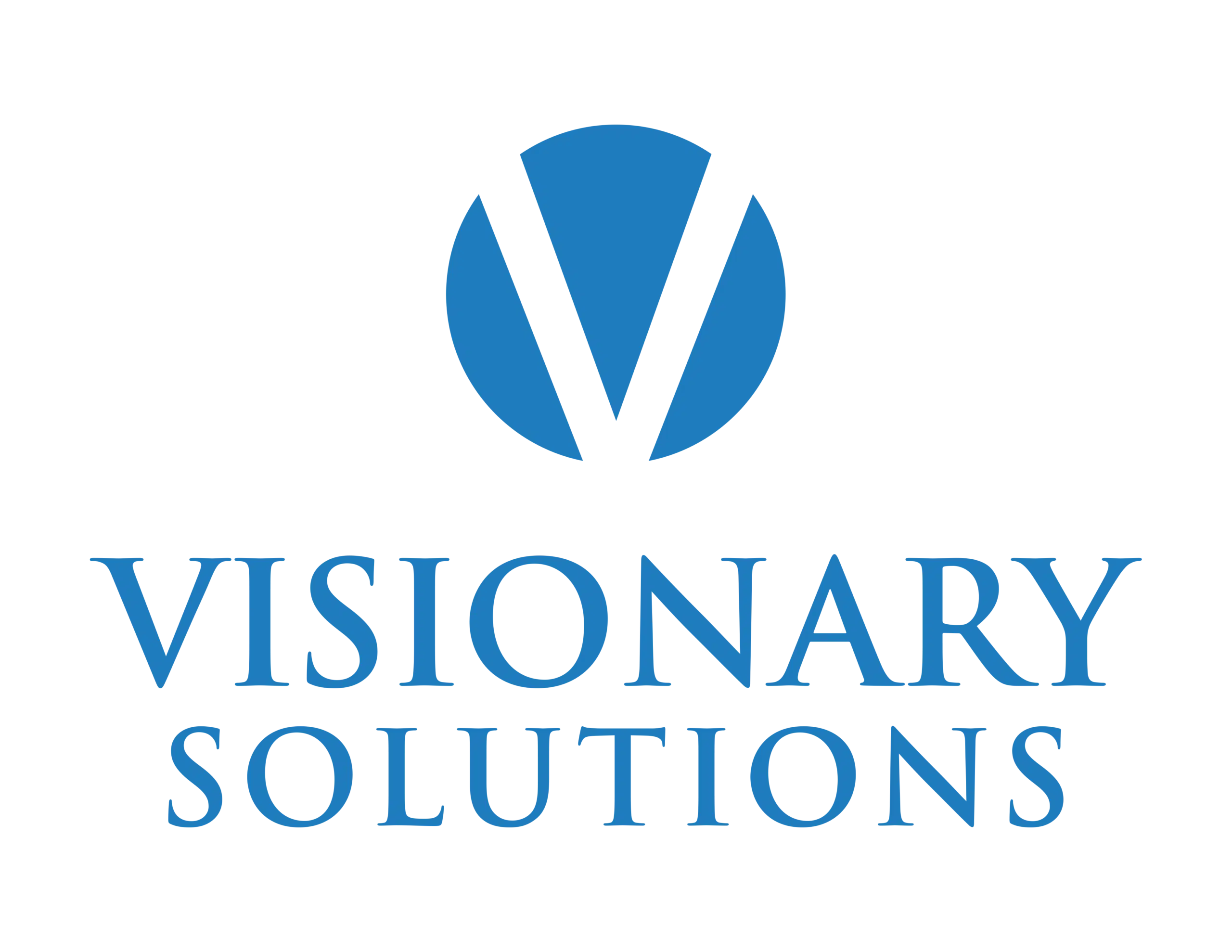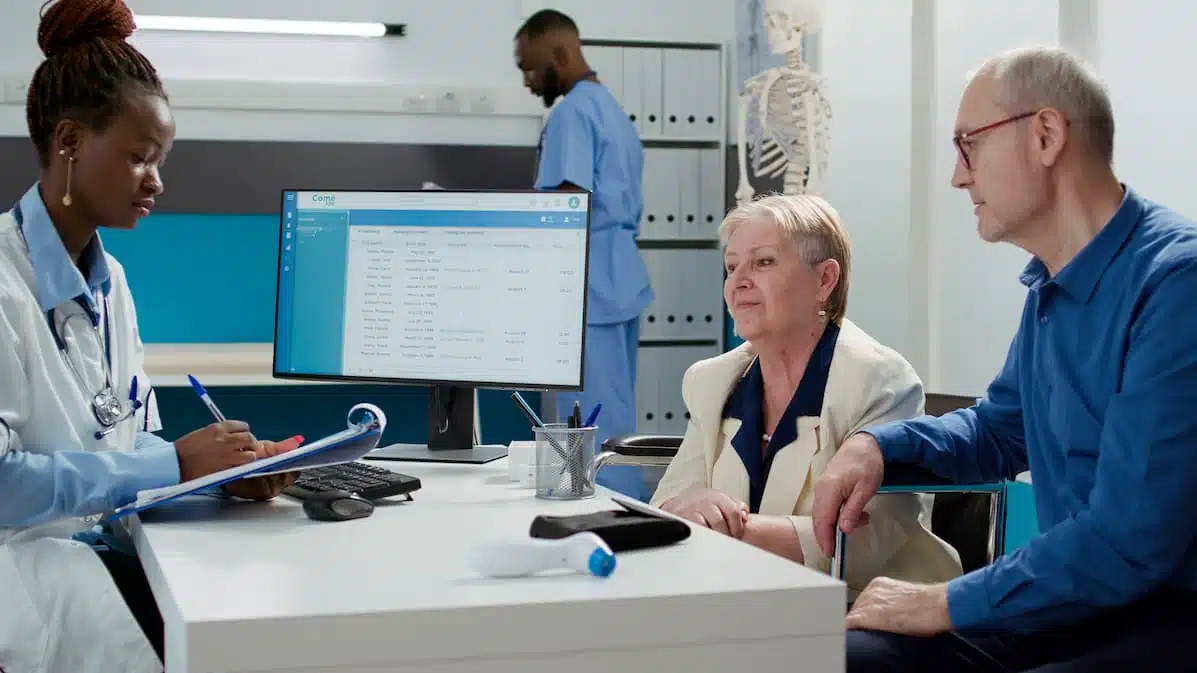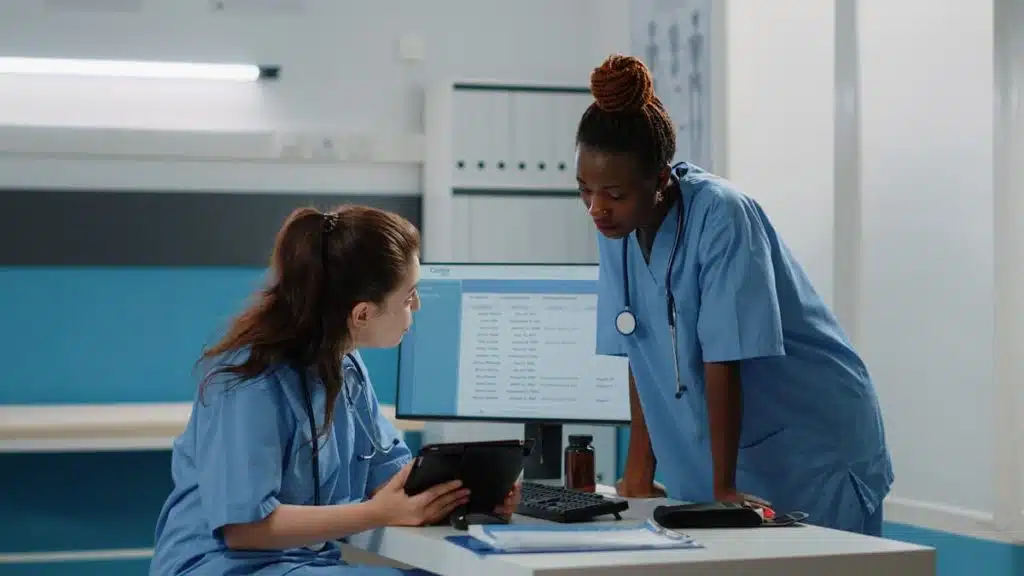Imagine a bustling medical clinic where the waiting area is packed. Some are nervously checking their watches, while others sit with resigned expressions as the minutes turn into hours.
Meanwhile, the staff is rushing from one examination room to another, juggling a multitude of cases with varying degrees of complexity.
The chaos, frustration, and discomfort that can arise in this scenario underscore the importance of efficient patient scheduling. This is the system that governs the allocation of appointments and resources in a healthcare facility.
Whether your next patient is scheduled for a regular check-up or dealing with a pressing medical issue, the way their visit is organized can make a substantial difference in their experience.
In this article, we’ll delve into its critical role, exploring the challenges it addresses, its inherent importance, and the emerging trends that promise to reshape this field.
What is Patient Scheduling?
Patient scheduling is a fundamental aspect of healthcare management that plays a crucial role in ensuring the efficient and effective delivery of medical services.
It is the process of coordinating and organizing patients appointments, consultations, and procedures within a healthcare facility.
This critical function ensures that providers can optimize their time, resources, and personnel to meet the needs of their patients while maintaining a well-organized and structured practice.
Patient scheduling involves a variety of types, methodologies, and technologies that collectively aim to streamline the healthcare experience for both patients and providers.
Types of Patient Scheduling
There are several types of patient scheduling methods employed in healthcare, each tailored to meet the specific needs and characteristics of a medical practice.
These include:
- Open Scheduling: This is characterized by allowing patients to select their preferred appointment slots.
This approach provides flexibility but may lead to challenges in maintaining a structured calendar. - Wave Scheduling: Wave scheduling groups patients into predefined time slots, typically at the start of each hour.
This method ensures a constant flow of patients, reducing waiting times. - Double Booking Scheduling: In situations where patients’ needs are urgent or uncertain, double booking can be employed.
This involves scheduling two patients for the same time slot.
While it ensures quick access to care, it may lead to delays and require effective time management. - Stream Scheduling: This method segregates patients based on the nature of their appointments.
For example, routine check-ups and minor issues are scheduled separately from more complex or lengthy procedures.
Methodologies in Patient Scheduling
Methodologies are essential for ensuring patients receive timely and appropriate care.
These involved include:
- Time-Based Scheduling: This approach involves setting specific time slots for appointments, such as 15 or 30 minutes, depending on the nature of the patient’s needs.
- Cluster Scheduling: Cluster scheduling groups patients with similar medical conditions or needs into specific time blocks.
This allows healthcare providers to allocate their resources and expertise more effectively. - Open Access Scheduling: In open access scheduling, patients can request appointments for the same day or within a short lead time, enhancing accessibility and reducing the need for future scheduling.
- Rotating Scheduling: Healthcare facilities may employ a rotating schedule, where different healthcare providers take turns seeing patients to ensure even distribution of workloads.
Technologies in Patient Scheduling
Modern healthcare practices increasingly rely on technology to streamline patient scheduling processes.
Electronic Health Records (EHR) and Practice Management Systems (PMS) are instrumental in managing patient appointments, maintaining records, and improving patient engagement.
Additionally, online portals and mobile applications empower patients to book appointments, receive reminders, and communicate with their providers.
The integration of telehealth and telemedicine technologies has also revolutionized patient scheduling.
Remote consultations have become an integral part of the field, offering patients greater flexibility and access to such services.
These enable healthcare providers to efficiently manage their patient schedules while expanding their reach to more patients.
The Challenges of Patient Scheduling
This is a cornerstone of effective healthcare delivery, playing a pivotal role in ensuring that patients receive timely and appropriate care.
However, the landscape of healthcare scheduling is fraught with various challenges for both providers and patients.
These challenges not only impact the quality of care but also have significant financial implications.
Common Issues in Patient Appointment Management
One of the foremost challenges in patient scheduling is the issue of overbooking.
Healthcare providers often grapple with the delicate balance between meeting the demand for medical services and ensuring that patients receive adequate time and attention during appointments.
Overbooking, a common practice aimed at maximizing the utilization of healthcare resources, can lead to rushed appointments, frustrated patients, and reduced quality of care.
For instance, a study published in the Journal of Medical Practice Management found that overbooking in primary care practices is a significant source of patient dissatisfaction and can compromise such relationships.
Another persistent issue is patient no-shows. These disrupt the daily schedule of providers, create inefficiencies, and result in lost revenue.
Patients’ failure to attend appointments can lead to delayed diagnosis and treatment, affecting their outcomes.
Additionally, understaffing poses a unique challenge. It’s often a result of workforce shortages, and it can lead to long wait times for appointments.
For instance, the shortage of primary care physicians in certain regions has resulted in patients waiting weeks or even months for an available appointment.
These delays can have dire consequences, especially in cases where early intervention is critical, such as cancer diagnosis or management of chronic conditions.
The Financial Implications of Patient Appointment Scheduling
The challenges in patient scheduling have significant financial implications.
For healthcare providers, the costs can be substantial.
Overbooking may create the illusion of increased efficiency but can result in disgruntled patients who may switch providers, causing a loss of revenue.
Moreover, overburdened staff may experience burnout, leading to increased turnover rates, and the costs associated with hiring and training new workers.
To mitigate these implications, providers can invest in scheduling software and systems that optimize patient flow and allocate appropriate time for appointments, reducing overbooking-related problems.
On the other hand, when they miss scheduled appointments, valuable healthcare resources go underutilized, leading to lost revenue. Providers may also experience increased administrative costs in trying to contact and reschedule no-show patients.
Implementing reminder systems, such as text messages or email alerts, can help reduce no-show rates and enhance engagement.
Some facilities charge patients for missed appointments to recoup some of the losses.
Furthermore, understaffing due to workforce shortages can lead to increased costs for healthcare providers.
Temporary staff, overtime, and locum tenens physicians are often brought in to fill the gaps, which can be expensive.
Professionals may also face penalties for failing to meet appointment time regulations, affecting their reimbursements.
To alleviate this challenge, healthcare institutions can invest in training and development programs, offer competitive salaries to attract talent and explore telehealth solutions to expand their reach.
8 Reasons Why Patient Scheduling is So Important
Effective patient scheduling plays a multifaceted role in ensuring operational efficiency, patient satisfaction, and the overall quality of care.
Let’s delve into eight compelling reasons why it is critically important:
-
Optimal Resource Allocation
Patient scheduling ensures that healthcare providers have a clear understanding of their daily workload.
By coordinating appointments, clinics and hospitals can allocate resources efficiently, minimizing idle time and overworking staff.
This not only enhances the productivity of healthcare professionals but also leads to cost savings.
-
Reduced Wait Times
This helps reduce patient wait times, a critical factor in the healthcare experience.
By assigning appointments strategically, clinics can minimize delays and improve patient flow.
They appreciate being seen promptly, which in turn boosts satisfaction and overall perceptions of care quality.
-
Enhanced Patient Satisfaction
Patient scheduling significantly impacts satisfaction.
When patients can secure timely appointments, they feel more valued and cared for.
An organized scheduling system also minimizes appointment mix-ups, avoiding frustrating errors that can negatively affect their experiences.
-
Improved Healthcare Access
Effective scheduling ensures that patients can access healthcare services when they need them.
This is particularly important for those with chronic conditions, as timely access to care can prevent complications and improve health outcomes.
-
Quality of Care
This has a direct impact on the quality of healthcare services.
It allows professionals to allocate sufficient time to each case, ensuring comprehensive assessments, thorough consultations, and reduced likelihood of diagnostic errors.
Quality care requires adequate time and attention, which effective scheduling facilitates.
-
Streamlined Administrative Tasks
In addition to clinical benefits, patient scheduling simplifies administrative tasks.
Electronic systems can automate appointment reminders, insurance verification, and billing, reducing the workload on administrative staff and minimizing errors in these critical areas.
-
Improved Operational Efficiency
This strategic approach promotes operational efficiency within healthcare facilities.
When appointment slots are used optimally, it minimizes underutilization of resources, such as examination rooms and medical equipment, and results in shorter patient turnaround times.
This not only benefits healthcare providers but also enhances the overall patient experience.
-
Data-Driven Decision-Making
These systems generate valuable data that can be analyzed for process improvement.
By tracking appointment trends, no-show rates, and patient preferences, organizations can make informed decisions to enhance care and optimize resource allocation.
How to Schedule Patients Effectively? Practical Tips
Here, we’ll explore some practical tips for scheduling patients effectively, encompassing both the use of technology and honing human skills.
Leverage Technology
- Implement a Robust Electronic Health Record (EHR) System: This streamlines patient information and scheduling, making it easy to access records and appointment history.
It minimizes scheduling errors and ensures that healthcare providers have all relevant patient data at their fingertips. - Integrate Appointment Scheduling Software: Many healthcare facilities use appointment scheduling software, which allows patients to book appointments online and offers real-time scheduling updates.
These systems can also send automated reminders, reducing no-show rates. - Use Telemedicine Platforms: This has gained prominence, especially in light of recent events.
Integrating such technology into your scheduling can be highly efficient for follow-up appointments and minor consultations.
It not only saves patients’ time but also optimizes the schedule for the facility.
Human Skills and Communication
- Effective Communication: Empower your staff with excellent communication skills.
They should be able to speak clearly with patients, understanding their needs and constraints.
Politeness, active listening, and empathy go a long way in building a strong relationship. - Block Scheduling: This involves grouping similar appointment types or procedures together during specific time slots, allowing healthcare providers to focus on similar tasks without frequent context switching.
- Patient Preferences: Inquire about patients’ preferences regarding appointment times and methods of communication.
Respecting their choices can enhance satisfaction and compliance.
Efficiency and Flexibility
- Define Time Slots: Assign specific time slots for different appointment types.
For instance, routine check-ups might require shorter periods, while complex procedures need longer ones.
This ensures that each patient receives the appropriate time and attention. - Overbooking and Waitlists: Develop a system for overbooking or maintaining a waitlist.
While this should be done judiciously to avoid overburdening staff, it can help fill slots opened due to cancellations or rescheduled appointments. - Room Utilization: Ensure that the examination rooms are allocated efficiently, minimizing downtime between patients.
Streamlined Administrative Processes
- Follow-Up Protocols: This ensures that patients who require further care or tests are scheduled promptly, preventing gaps in treatment plans.
- Provider Input: Encourage healthcare providers to be involved in the scheduling process.
They can provide valuable insights into their availability, preferred scheduling practices, and special considerations for specific cases. - Regular Reviews and Adjustments: Schedule regular meetings to review scheduling practices.
Make adjustments based on performance data, patient feedback, and staff recommendations.
Continuous improvement is key to maintaining an efficient scheduling system.
Patient Scheduling Workflow
An optimized patient scheduling workflow not only ensures that patients are seen promptly but also contributes to overall satisfaction.
Step 1: Appointment Booking
The patient scheduling process commences with appointment booking.
Traditionally, this was done via phone calls, often leading to long hold times and potential errors in transcription. However, technology has revolutionized this step.
Many facilities now offer online appointment scheduling through their websites or dedicated scheduling platforms.
Patients can conveniently choose their preferred time slots, reducing the chances of double bookings and errors.
This technology-driven approach not only enhances efficiency but also empowers patients to have more control over their healthcare journey.
Step 2: Appointment Confirmation
After the appointment is booked, technology continues to play a pivotal role in sending automated confirmation reminders.
Patients receive emails, text messages, or automated phone calls, which reduce no-show rates and ensure that they remember their appointments.
This proactive communication helps maintain the schedule and ensures that healthcare providers can make the most of their time.
Nevertheless, the human touch isn’t lost here; staff members are often available to answer patient queries, provide directions, and offer reassurance to those who may feel anxious about their upcoming visit.
Step 3: Pre-Visit Preparation
In the days leading up to the appointment, patients might need to complete pre-visit preparations such as fasting, medication adjustments, or specific tests.
Technology can send reminders and instructions to patients through electronic channels.
Meanwhile, the human element can involve nurses or medical assistants calling them with more complex requirements to offer personalized guidance, address concerns, and ensure that they are adequately prepared for their visit.
Step 4: Arrival and Check-In
On the day of the appointment, patients arrive at the medical facility.
Self-check-in kiosks, another technology-driven innovation, can expedite this process.
Patients can confirm their arrival and update personal information, insurance details, or other necessary documentation efficiently.
Staff members are also available to assist those who may require support in navigating the process or have specific questions or needs.
Step 5: Consultation and Care
The core of the patient scheduling workflow is the consultation with healthcare providers.
Electronic health records (EHR) systems ensure that information is readily available to the team, enabling efficient and accurate care.
This aids in real-time documentation, medication management, and communication, ensuring that the patient receives the highest standard of care.
Step 6: Post-Visit Follow-Up
After the consultation, technology continues to assist with post-visit follow-up.
Electronic prescriptions, test results, and appointment scheduling for follow-up consultations can be conducted efficiently and securely.
At the same time, human interaction, often through nurses or administrative staff, can play a crucial role in addressing any concerns or uncertainties that the patient might have.
A personal touch in these moments is valuable for patient reassurance and understanding.
Navigating the Best Patient Scheduling Software
NexHealth has earned a reputation as one of the best patient scheduling softwares in this realm.
With seamless integration directly into health record systems, it offers a compelling solution for healthcare practices.
In this section, we’ll delve into why it is considered one of the top choices, with a focus on its user-friendliness, feature-rich offerings, and integration capabilities.
User-Friendly Interface
NexHealth prides itself on providing an intuitive, easy-to-navigate platform.
This ensures a hassle-free experience for both staff and patients.
It simplifies the appointment scheduling process, ultimately leading to an enhanced overall patient experience.
Furthermore, it streamlines rescheduling and appointment cancelation processes, contributing to error reduction.
Features
Its feature set is comprehensive and impactful, including real-time online scheduling, automated appointment reminders, patient messaging, digital forms, online payment capabilities, robust reporting tools, and a convenient virtual waitlist feature.
These empower healthcare practices to optimize their workflows, boost patient engagement, and enhance overall operational efficiency.
Seamless Integration
One of its standout strengths is its seamless integration with health record systems.
This ensures that patient information remains consistent across various platforms, a crucial aspect of well-informed decision-making in healthcare.
The Future of Scheduling Patients
In the ever-evolving landscape of healthcare, the future of medical patient scheduling is poised for exciting transformations.
As technology continues to advance and healthcare systems aim to improve access to care, scheduling is undergoing a significant overhaul.
Innovations in Patient Scheduling Systems
The future of patient scheduling systems is being increasingly influenced by artificial intelligence (AI) and machine learning technologies.
These innovations are set to revolutionize the way healthcare providers manage appointments, improving both efficiency and patient satisfaction.
They can analyze a myriad of data points, including patient preferences, historical appointment patterns, and even external factors like weather or traffic.
This enables providers to offer more accurate and personalized scheduling options.
Machine learning algorithms can predict appointment no-shows and late cancellations, allowing to optimize their scheduling and reduce costly gaps in the daily calendar.
These softwares can send automated reminders and notifications to patients, reducing the chances of missed appointments and streamlining the overall process.
Furthermore, the integration of telehealth and telemedicine services into scheduling platforms is another pivotal development.
As remote consultations become more common, these are evolving to seamlessly coordinate both in-person and virtual appointments.
This approach enhances accessibility to care and accommodates the changing expectations of patients who increasingly seek flexibility in their appointments.
Tailoring Patient Scheduling Best Practices for Excellence
A one-size-fits-all approach no longer suffices in this diverse landscape. Various environments have unique requirements and patient demographics, making customization of scheduling practices essential.
Healthcare professionals have recognized that optimizing patient scheduling is not only about embracing cutting-edge technology but also tailoring their approach to meet specific needs.
For example, pediatric clinics might design their systems to include shorter, more frequent appointment slots to accommodate the shorter attention spans of children and their caregivers.
In contrast, a specialized cancer treatment center could implement flexible scheduling, allowing patients to choose their treatment times, thus offering a sense of control and reducing anxiety.
Customized scheduling practices have already demonstrated their effectiveness in enhancing efficiency and patient satisfaction.
For instance, many obstetrics and gynecology practices have introduced self-scheduling options, enabling expecting mothers to select the most convenient time for prenatal check-ups, reducing the burden on administrative staff, and offering more flexibility to patients.
Moreover, the COVID-19 pandemic has underscored the importance of adaptability in this regard. Providers had to quickly pivot to accommodate new safety measures and shifting patient needs.
Flexible scheduling practices allowed clinics to adjust quickly to accommodate telehealth appointments, testing, and vaccination scheduling, ensuring that delivery remained accessible and efficient even during these challenging times.
In the future, these practices will continue to be essential, addressing the unique demands of different medical specialties, patient demographics, and healthcare delivery methods.
Conclusion
The significance of patient scheduling in the healthcare industry cannot be overstated.
We’ve delved into the key insights, challenges, and solutions associated with this critical aspect. From the importance of efficient scheduling to reduce patient wait times and enhance overall satisfaction, to the challenges posed by no-shows and backlogs, we’ve explored the multifaceted nature of this vital process.
The solutions are equally varied and encompass the utilization of advanced software and tools, the implementation of reminder systems, and the adoption of flexible options.
These approaches not only improve the experience but also optimize resource utilization and revenue generation for healthcare providers.
As we move forward, it’s imperative for entities to recognize that this is not a static process but a dynamic one that demands continuous innovation and optimization.
What you must do is clear: prioritize patient scheduling by embracing technology, data-driven strategies, and client-centric approaches.




